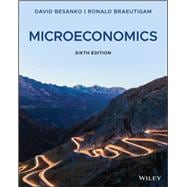Microeconomics is a classroom-tested resource for learning the key concepts, essential tools, and applications of microeconomics. This leading textbook enables students to recognize and analyze significant data, patterns, and trends in real markets through its integrated, student-friendly approach to the subject — providing practice problems, hands-on exercises, illustrative examples, and engaging applications that ground theory firmly in the real world. Each chapter, opening with a set of clearly defined learning goals based on the Bloom Taxonomy, features numerous Learning-by-Doing (LBD) problems, mathematical and graphical data, and varied problem sets focused on current events.
Now in its sixth edition, the text offers extensive new and revised content throughout. All applications reflect current data and important new developments in the field of economics, including behavioral economics, randomized controlled trials (RCTs) in policy evaluation and design, and computational-based microeconomics. Updated chapter openers, designed to increase student interest, cover topics including the economic impacts of climate change, U.S. household income and spending, surge pricing by Uber and Lyft, the effect of immigration on wages, and advances in robotics, automation, artificial intelligence, and more.








